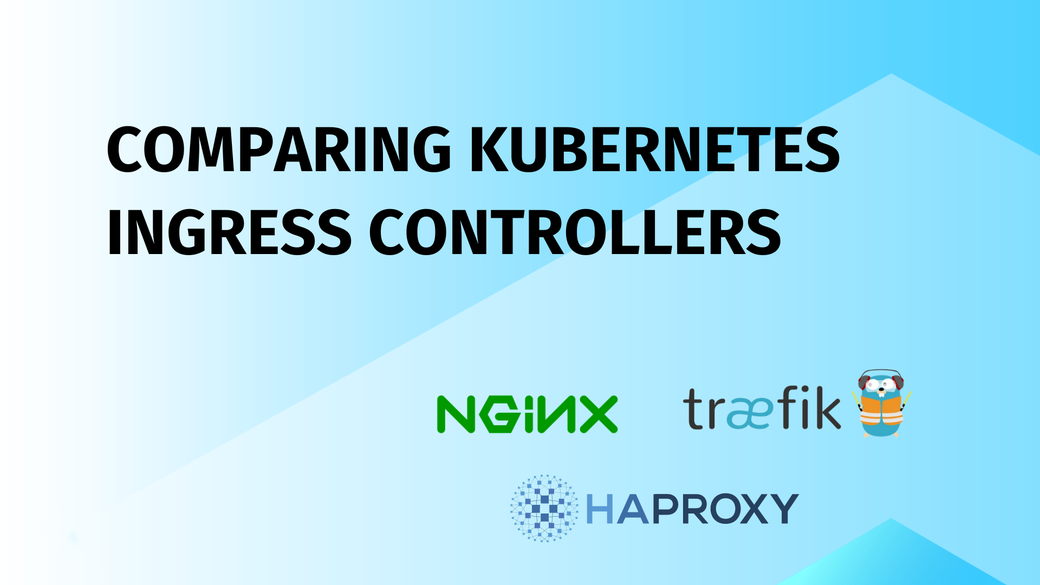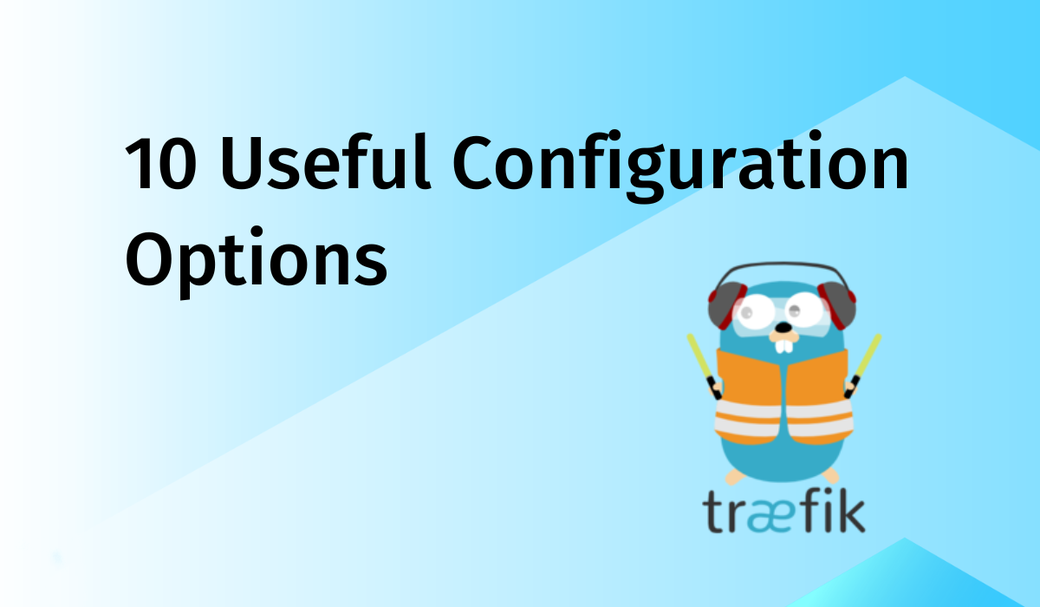Table of Contents
If you are running a Kubernetes cluster, you probably need an ingress controller. An ingress controller is a Kubernetes resource responsible for overseeing external access to the services within your cluster. This access is typically established through HTTP(S) requests, but protocols such as WebSockets or gRPC can also be used. Essentially functioning as a reverse proxy, the controller directs incoming traffic to the relevant backend service according to the rules defined in an associated Ingress object.
Kubernetes does not include an ingress controller by default. Instead, you must install one yourself from the many options available, such as Nginx, Traefik, and HAProxy. While they all provide the same core functionality, each has specific benefits and drawbacks.
Choosing the right ingress controller for your Kubernetes cluster is important because it can affect the availability, reliability, and security of your services. It can also impact the ease of use and maintenance of your cluster. Consequently, it’s important to choose an ingress controller that suits your specific requirements and preferences without compromising on the quality and performance that your applications and services need.
In this article, you’ll learn how the Nginx, Traefik, and HAProxy ingress controllers compare across several criteria, including features, performance, scalability, security, and ease of configuration. When you’re done, you’ll be well-positioned to do further research and make an informed choice about which controller best meets your needs.
Begin by looking at Nginx.
#Nginx Ingress Controller
First released in 2004, Nginx is widely used as both a web server and a reverse proxy. Many engineers are already familiar with Nginx outside of the Kubernetes context, which makes it an approachable choice for a Kubernetes Ingress Controller.
It’s especially robust when dealing with high traffic volumes, making it a good fit for large-scale applications that need to handle many simultaneous connections and frequent traffic spikes. Nginx also handles SSL/TLS termination, providing a secure channel for transmitting sensitive data.
What sets Nginx apart is its configurability. Thanks to a sophisticated configuration language, it can manage complex routing scenarios with ease. For example, it supports geo-based routing to direct traffic based on users' geographical locations and can balance traffic among different versions of backend services, making it easy to stress new versions of services.
#Ease of Use and Configuration
With extensive documentation and community support, Nginx offers a relatively smooth experience in configuration and deployment—once engineers learn its configuration language. Nginx uses a custom configuration language, and it can be a challenge to learn, even for veteran engineers.
The Nginx configuration language syntax is unique and doesn’t resemble common programming languages. It offers more flexibility than the YAML configuration commonly used in the Kubernetes ecosystem, but understanding how to properly use blocks, directives, parameters, and other features of the language can be confusing for newcomers.
#Key Advantages and Strengths
As the world’s most popular web server, Nginx is well-known and has a large pool of experienced engineers. This can be an advantage in hiring and team collaboration. The Nginx Ingress Controller is also maintained by the Kubernetes project, so it is well-documented and well-supported. Its robust performance and scalability make it suitable for handling heavy traffic loads without compromising speed.
Nginx also has a comprehensive feature set, which includes rate limiting to prevent abuse; caching for improved performance; WebSockets support for real-time applications; and HTTP/2, HTTP/3, and gRPC proxying. It also has a wide variety of third-party modules, so if Nginx doesn’t have a feature you need, there’s a good chance someone has added it. It has an extensive API for creating extension modules and even offers a Rust SDK that makes it possible to build fast, safe extensions to cover any imaginable use case.
#Limitations and Potential Issues
The extensive capabilities of Nginx are overkill for simple use cases, leading to unnecessary complexity when a simpler, more user-friendly solution like Traefik will suffice. As mentioned, Nginx can be complex and difficult for beginners due to its advanced configuration language. Although this is a potential limitation, it can also be a strength for organizations willing to provide their platform engineers with time and training to understand the full range of capabilities of Nginx.
#When You Should Use Nginx
If your team has prior experience with Nginx or your application demands sophisticated routing and performance features, such as low-latency streaming for live broadcasts, session persistence for maintaining user experience, or real-time communication for collaborative tools, Nginx could be the right fit.
If you’re running bleeding-edge applications that require new protocols or routing capabilities other ingress controllers don’t offer, the Nginx extension API is a good choice if you have the engineering talent available to add features yourself.
#Traefik Ingress Controller
Traefik is a modern load balancer and reverse proxy designed with microservices in mind. It offers a simpler, more dynamic approach than other ingress controllers with its ability to automatically discover new service configurations.
If you’re working in a microservices architecture where you frequently add or modify services in your Kubernetes cluster, Traefik can automatically detect these changes and update its configuration accordingly. This feature reduces manual effort, minimizing the chance of human error and making it easy to get new services into production quickly.
The lightweight design of Traefik allows for quick scaling, making it well-suited for applications that need to adapt rapidly to changing demand. Its autodiscovery capabilities integrate well with Kubernetes scaling mechanisms, allowing your cluster to quickly spin up additional instances of Traefik as needed.
#Ease of Use and Configuration
Traefik is intuitive and user-friendly, providing a more graphical approach compared to other ingress controllers. It uses annotations or custom resources to define the routing rules in Kubernetes. It also features dynamic configuration capabilities, which makes initial setup and ongoing maintenance easier. The automatic discovery and configuration capabilities also provide a less steep learning curve compared to Nginx, making Traefik accessible even for those new to ingress controllers.
#Key Advantages and Strengths
The automatic service discovery of Traefik greatly simplifies cluster management and aligns well with the dynamic nature of containerized applications. Its lightweight nature and focus on simplicity make it suitable for fast deployments, especially in cloud-native environments. Traefik is ideal for a large percentage of Kubernetes workloads that need to reliably route external requests to services inside the cluster but don’t need the more advanced features and higher performance of Nginx or HAProxy.
For most use cases, the ease of setup and maintenance of Traefik are its greatest strengths because most platform engineering teams have more work to do than available time. Traefik generally does its job well and requires minimal attention, leaving engineers more time to spend on all the challenges faced in maintaining and scaling application infrastructure.
#Limitations and Potential Issues
While powerful and flexible in its domain, Traefik lacks some advanced features found in other ingress controllers, such as complex traffic routing and fine-grained rate limiting. This could be a limitation for highly specialized use cases.
Traefik does not support distributed Let’s Encrypt certificates in its open source version, meaning you can’t use Let’s Encrypt when running several instances of Traefik for high availability. However, this feature is available through Traefik Enterprise or by using a certificate controller such as cert-manager.
#When You Should Use Traefik
If you’re looking for a solution that is easy to set up, scales effortlessly with your applications, and integrates smoothly in environments where services frequently change, Traefik might be the way to go. Its focus on simplicity and dynamism makes it especially appealing for cloud-native applications and agile development workflows.
Additionally, if your team is new to Kubernetes, Traefik provides a relatively gentle on-ramp compared with other ingress controller options.
#HAProxy Ingress Controller
HAProxy is a mature and robust reverse proxy and load balancer that supports a variety of load-balancing algorithms, such as round-robin, least connections, and source IP hash. It also allows for fine-grained control over things like the weighting of backend servers.
HAProxy offers features like header manipulation, along with TCP and HTTP header analysis, that enable you to intelligently modify and route requests and responses. These features are essential for high-traffic websites that need to distribute requests according to specific criteria and perform complex routing logic. HAProxy also provides advanced health checks to ensure backend server availability, which is especially important for critical applications.
Like other ingress controllers, HAProxy can handle multiple protocols, including TCP, HTTP, and gRPC, and provide TLS termination, meaning you don’t miss out on important functionality if you choose HAProxy for its advanced routing capabilities.
#Ease of Use and Configuration
The rich configuration options of HAProxy provide a granular level of control, though this flexibility might necessitate a steeper learning curve. HAProxy is more difficult to configure than Traefik but is usually simpler than Nginx. Like Nginx, HAProxy uses a custom configuration language, and although it’s less sophisticated, it is also easier to learn and use. High-quality documentation and community resources are available but are less extensive than for Nginx and Traefik.
#Key Advantages and Strengths
HAProxy has sophisticated load-balancing capabilities that go beyond basic request distribution and enhanced performance options, such as SSL offloading, HTTP/2 and HTTP/3 support, and content caching. This wide range of options allows engineers to tailor strategies for their particular needs. Its built-in reliability features, such as server health checks, connection queuing, and session persistence, contribute to its reputation for fault tolerance.
HAProxy performs well in benchmarks compared to both Traefik and Nginx, and HAProxy supports more load-balancing algorithms than either of them.
#Limitations and Potential Issues
The richness and complexity of HAProxy make it less suitable for more straightforward use cases or where quick setup is a priority. Specialized support and preconfigured examples are also harder to find compared to more popular options like Nginx. Although the HAProxy documentation is comprehensive and well-written, Nginx and Traefik have more blog posts, tutorials, and Stack Overflow answers covering a wider range of use cases and problems.
#When You Should Use HAProxy
If your environment requires precise control, tailored load-balancing strategies, and robust fault tolerance, HAProxy could be the right choice. Its advanced capabilities are particularly beneficial for mission-critical applications, such as real-time financial systems, large e-commerce sites, and high-throughput APIs.
#Conclusion
Selecting the right ingress controller is not a one-size-fits-all decision. It depends on your team’s skills, the specific demands of your applications, and your long-term objectives.
Here’s a quick summary table comparing the options:
| Ingress Controller | Strengths | Weaknesses |
|---|---|---|
| Nginx | Large talent pool, robust features, comprehensive routing controls, extension API | Complex configuration language, overkill for simpler use cases |
| Traefik | Intuitive, dynamic service discovery, easy scaling, easy maintenance | Lacks some specialized features, potentially less robust for complex scenarios |
| HAProxy | Advanced customizable load balancing, high reliability, high performance | Richness and complexity may slow setup, less community support for specialized use cases |
As you’ve seen, each ingress controller has its own pros and cons, so there’s no definitive answer as to which one is the best; the decision comes down to your unique requirements and challenges. Consider what you’ve learned and check the documentation for each ingress controller to learn more about how each of them handles the aspects of Kubernetes ingress control most relevant to your use case.










